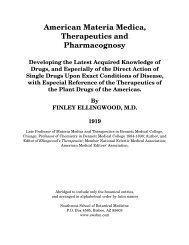Individual Drugs. ABIES (Tsuga canadensis). - Southwest School of ...
Individual Drugs. ABIES (Tsuga canadensis). - Southwest School of ...
Individual Drugs. ABIES (Tsuga canadensis). - Southwest School of ...
Create successful ePaper yourself
Turn your PDF publications into a flip-book with our unique Google optimized e-Paper software.
active capillary movement; and in enfeeblement <strong>of</strong> the circulation,<br />
functional in character and not due to structural degeneration or<br />
sepsis, and manifested by a frequent small pulse, a hard and wiry<br />
pulse, a frequent, open and easily compressed pulse, a rebounding<br />
pulse, or an irregular pulse. It lessens determination <strong>of</strong> blood<br />
(hyperaemia), quiets irritation, checks the rapid circulation in the<br />
capillaries when it is too active, and increases the circulation when it<br />
is sluggish. We account for this by believing that it gives the right<br />
innervation to the vascular system. Scudder (Diseases <strong>of</strong> Children, 42)<br />
says <strong>of</strong> it: “I have been in the habit <strong>of</strong> saying that aconite is a stimulant<br />
to the heart, arteries, and capillaries, because whilst it lessens the<br />
frequency, it increases the power <strong>of</strong> the apparatus engaged in the<br />
circulation.” It should be stated that our term sedative differs in fact<br />
from that accepted by other schools. An agent such as aconite, which<br />
in full doses would depress but in minute doses will stimulate the<br />
vascular system to normal activity and thereby reduce febrile states by<br />
correcting or regulating innervation, is classed in Eclectic therapy as a<br />
“special,” “vascular,” or “arterial sedative.”<br />
Aconite is a remedy for irritation <strong>of</strong> the mucous membranes. It matters<br />
little whether it be <strong>of</strong> the nares preceding an attack <strong>of</strong> coryza, <strong>of</strong> the<br />
larynx, <strong>of</strong> the bronchi, or <strong>of</strong> the gastro-intestinal tube, liable to lead to<br />
inflammation <strong>of</strong> those tracts, aconite may be used to control the morbid<br />
process. In simple gastric irritation with or without vomiting, in the<br />
irritative forms <strong>of</strong> diarrhoea—whether simple or <strong>of</strong> the more<br />
complicated forms <strong>of</strong> enteric inflammation, <strong>of</strong> cholera infantum, or <strong>of</strong><br />
dysentery—it is equally important and usually specifically indicated.<br />
In the diarrhoea <strong>of</strong> dentition it <strong>of</strong>ten controls the nervous symptoms<br />
and the discharges. Of course one must take into consideration the<br />
role played by food toxemia. In such cases modification or complete<br />
change <strong>of</strong> food must be resorted to, and frequently a simple purge given<br />
to cleanse the gastro-intestinal tract. Then if irritation persists, or there<br />
is fever, aconite usually acts promptly. The form <strong>of</strong> cholera infantum<br />
best treated by it is that showing increased bodily heat. If dentition is<br />
accompanied by irritation and fever, it may be given alone or with<br />
matricaria. In many <strong>of</strong> the stomach and bowel disorders, particularly<br />
gastric irritation with diarrhoea, and gastro-enteritis, it acts well with<br />
ipecac, or rhus. For aphthous ulcerations with fever, aconite and<br />
phytolacca internally with infusion <strong>of</strong> coptis locally have not been<br />
excelled. In simple dysentery, aconite, ipecac and magnesium<br />
sulphate is a most effective combination, seldom failing to control the<br />
Felter’s Materia Medica - (A) - Page 9
















